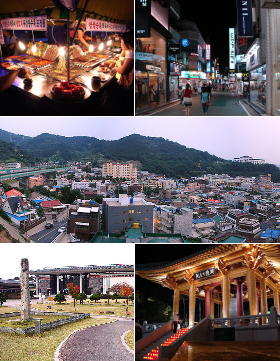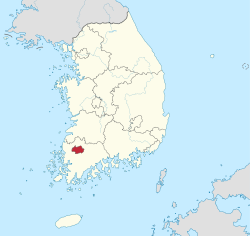Gwangju
광주광역시 | |
|---|---|
| Gwangju Metropolitan City 광주광역시 | |
| transcription(s) | |
| • Hangul | 광주광역시 |
| • Hanja | 光州廣域市 |
| • Revised Romanization | Gwangju-gwangyeoksi |
| • McCune–Reischauer | Kwangju-gwangyŏksi |
 Above:Badhoe Pojangmacha Street Restaurant, Geumnamo Shopping district Middle:Panorama view of resident area of Gwangsan District Bottom:Gwangju Folk Museum, Democracy Bell in Denman Estate Park (All items are left to right) | |
 | |
 | |
| Coordinates: 35°09′55″N 126°50′55″E / 35.16528°N 126.84861°E | |
| Country | |
| Region | Honam |
| Districts | 5 |
| Government | |
| • Type | Mayor–Council |
| • Mayor | Kang Gi-jung (Democratic) |
| • Body | Gwangju Metropolitan Council |
| Area | |
• Total | 501.24 km2 (193.53 sq mi) |
| Population (september 2024[1]) | |
• Total | 1,411,357 |
| • Density | 2,800/km2 (7,300/sq mi) |
| • Dialect | Jeolla |
| GDP | |
| • Total | KR₩ 45 trillion US$ 36 billion (2022) |
| Time zone | UTC+9 (Korea Standard Time) |
| Area code | +82-61 |
| ISO 3166 code | KR-29 |
| Flower | Royal Azalea |
| Tree | Ginkgo |
| Bird | Dove |
| Website | Official website (English) |
Gwangju[a] (Korean: 광주; Korean: [kwaŋ.dʑu] ), formerly romanized as Kwangju, is South Korea's sixth-largest metropolis. It is a designated metropolitan city under the direct control of the central government's Home Minister. The city was also the capital of South Jeolla Province Province until the provincial office moved to the southern village of Namak in Muan County in 2005 because Gwangju was promoted to a metropolitan city and was independent of South Jeolla Province.
Its name is composed of the words gwang (Korean: 광; Hanja: 光) meaning "light" and ju (주; 州) meaning "province". Gwangju was historically recorded as Muju (무주; 武州), in which "Silla merged all of the land to establish the provinces of Gwangju, Ungju, Jeonju, Muju and various counties, plus the southern boundary of Goguryeo and the ancient territories of Silla" in the Samguk sagi.[4] In the heart of the agricultural Jeolla region, the city is also famous for its rich and diverse cuisine.
- ^ "Population statistics". Korea Ministry of the Interior and Safety. 2024.
- ^ 2022년 지역소득(잠정). www.kostat.go.kr.
- ^ EB (1878), p. 390.
- ^ "Origin and History of Gwangju". www.gwangju.go.kr (in Korean). Archived from the original on 18 April 2018. Retrieved 18 April 2018.
Cite error: There are <ref group=lower-alpha> tags or {{efn}} templates on this page, but the references will not show without a {{reflist|group=lower-alpha}} template or {{notelist}} template (see the help page).




